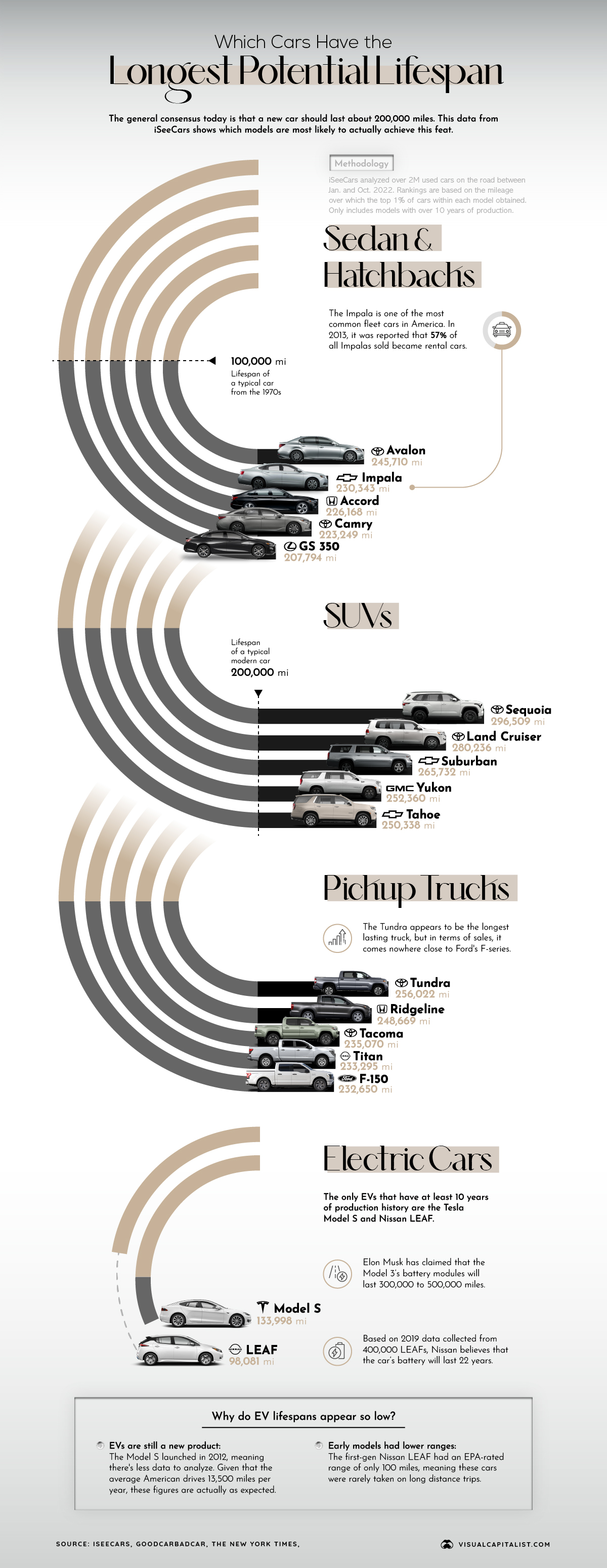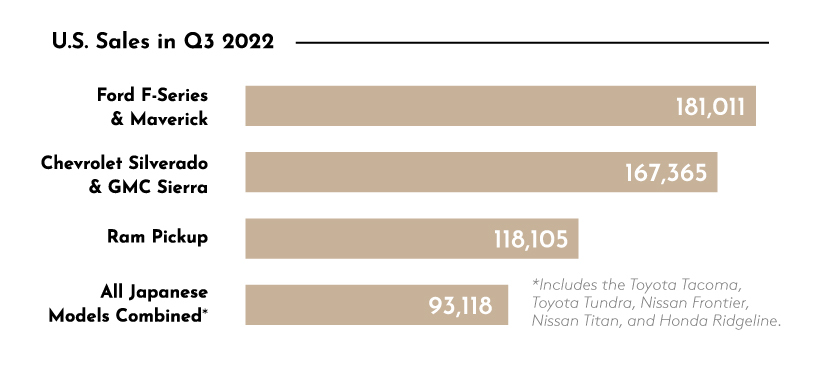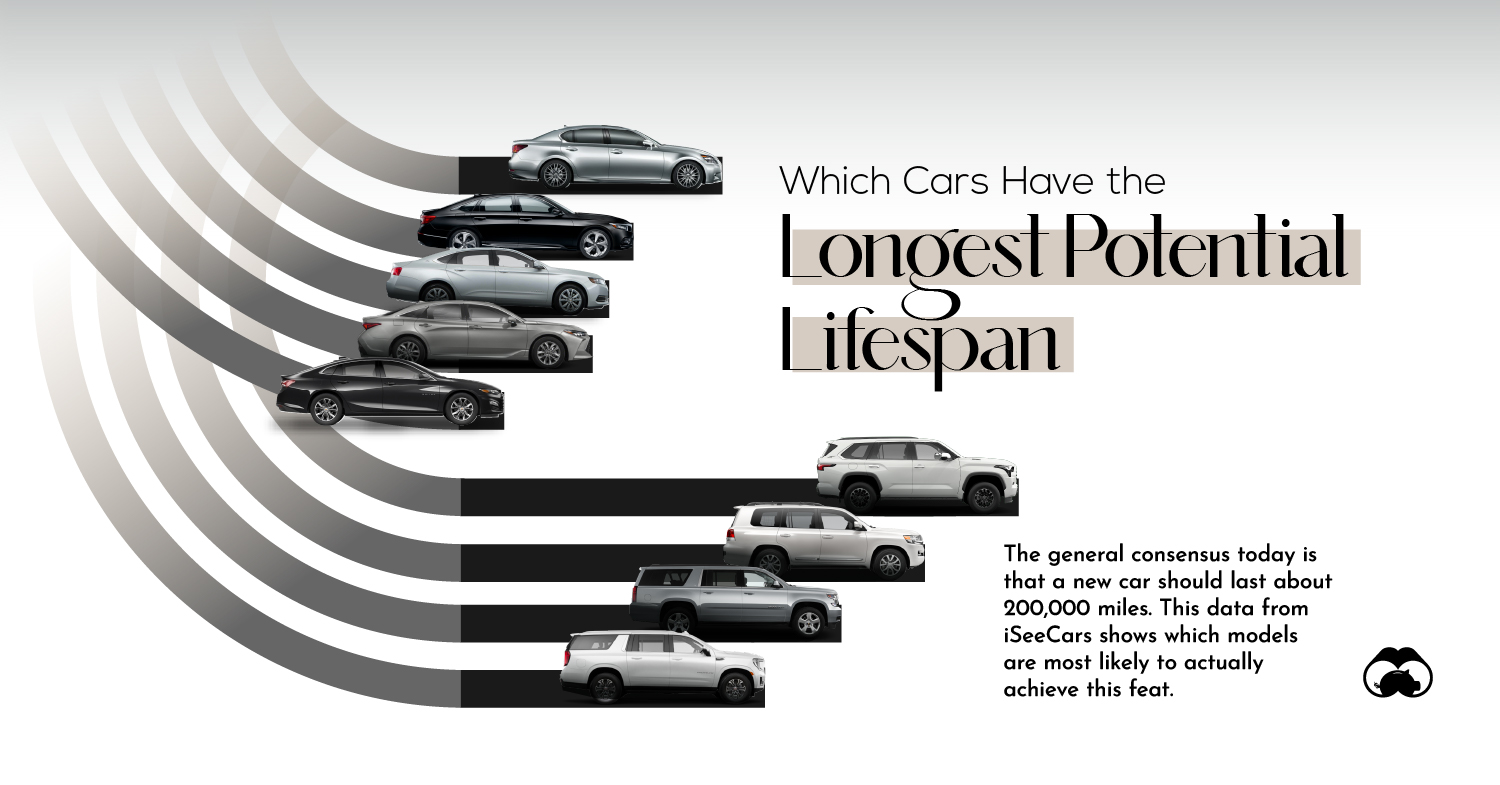Misc
Infographic: The Longest Lasting Cars, in Miles

Infographic: The Longest Lasting Cars, in Miles
When properly maintained, well-built cars can last an impressive amount of miles.
Consider this 2006 Honda Civic, which hit one million miles on its original engine and transmission. Amusingly, the car’s odometer maxes out at 999,999 miles.
While that case may be an extreme outlier, most modern cars are expected to last 200,000 miles before experiencing some significant failure. That’s roughly double the lifespan of cars from the 1960s and 1970s, which typically lasted about 100,000 miles.
In this infographic, we used data from iSeeCars to determine which cars are the most likely to reach— or even surpass—the 200,000 mile benchmark.
Study Methodology & Data
To come up with their rankings, iSeeCars analyzed over 2 million used cars between January and October 2022. The rankings are based on the mileage that the top 1% of cars within each model obtained. Models with less than 10 years of production, such as the Tesla Model 3, were excluded.
The following tables show an expanded list of the longest lasting cars, by model category. Our infographic only includes the top five from each.
Sedans & Hatchbacks
The only non-Japanese model in the top 10 is the Chevrolet Impala, which is one of the most commonly found rental cars in the U.S.
| Rank | Vehicle | Potential Lifespan (miles) |
|---|---|---|
| 1 | 🇯🇵 Toyota Avalon | 245,710 |
| 2 | 🇺🇸 Chevrolet Impala | 230,343 |
| 3 | 🇯🇵 Honda Accord | 226,168 |
| 4 | 🇯🇵 Toyota Camry | 223,249 |
| 5 | 🇯🇵 Lexus GS 350 | 207,794 |
| 6 | 🇯🇵 Honda Fit | 207,231 |
| 7 | 🇯🇵 Honda Civic | 205,335 |
| 8 | 🇯🇵 Lexus ES 350 | 204,642 |
| 9 | 🇯🇵 Toyota Corolla | 204,266 |
| 10 | 🇯🇵 Mazda 6 | 203,154 |
Another interesting takeaway is that Lexus is the only luxury brand in this list. This is likely due to the fact that Lexus and Toyota often share drivetrain components.
SUVs
iSeeCars has a larger top 20 list for the SUV category.
| Rank | Vehicle | Potential Lifespan |
|---|---|---|
| 1 | 🇯🇵 Toyota Sequoia | 296,509 |
| 2 | 🇯🇵 Toyota Land Cruiser | 280,236 |
| 3 | 🇺🇸 Chevrolet Suburban | 265,732 |
| 4 | 🇺🇸 GMC Yukon XL | 252,360 |
| 5 | 🇺🇸 Chevrolet Tahoe | 250,338 |
| 6 | 🇯🇵 Toyota Highlander Hybrid | 244,994 |
| 7 | 🇺🇸 Ford Expedition | 244,682 |
| 8 | 🇯🇵 Toyota 4Runner | 244,665 |
| 9 | 🇺🇸 GMC Yukon | 238,956 |
| 10 | 🇯🇵 Honda Pilot | 236,807 |
| 11 | 🇯🇵 Acura MDX | 228,472 |
| 12 | 🇺🇸 Cadillac Escalade ESV | 228,449 |
| 13 | 🇺🇸 Cadillac Escalade | 224,782 |
| 14 | 🇺🇸 Lincoln Navigator | 220,319 |
| 15 | 🇯🇵 Nissan Armada | 220,172 |
| 16 | 🇯🇵 Toyota Highlander | 218,075 |
| 17 | 🇯🇵 Honda CR-V | 215,930 |
| 18 | 🇺🇸 Lincoln Navigator L | 214,341 |
| 19 | 🇯🇵 Subaru Outback | 208,298 |
| 20 | 🇰🇷 Hyundai Santa Fe | 206,398 |
This is a more diverse list, with American and Japanese models seemingly on par. The GM family of SUVs (Tahoe, Suburban, Yukon, and Yukon XL) are narrowly edged out by Toyota’s full size options (Sequoia and Land Cruiser).
The Land Cruiser was discontinued in the U.S. for 2021, but it remains a very popular model in Middle Eastern countries like Bahrain, Qatar, and the UAE.
Pickup Trucks
Once again, Japanese manufacturers hold the top spots. According to Toyota, the Tundra is the only full-size pickup that is currently being built in Texas.
| Rank | Vehicle | Potential Lifespan |
|---|---|---|
| 1 | 🇯🇵 Toyota Tundra | 256,022 |
| 2 | 🇯🇵 Honda Ridgeline | 248,669 |
| 3 | 🇯🇵 Toyota Tacoma | 235,070 |
| 4 | 🇯🇵 Nissan Titan | 233,295 |
| 5 | 🇺🇸 Ford F-150 | 232,650 |
| 6 | 🇺🇸 Chevrolet Silverado 1500 | 230,515 |
| 7 | 🇺🇸 GMC Sierra 1500 | 222,691 |
| 8 | 🇺🇸 Ford Ranger | 220,980 |
| 9 | 🇯🇵 Nissan Frontier | 215,775 |
| 10 | 🇺🇸 Ram 1500 | 215,521 |
Despite their marginally higher potential lifespans, sales of Japanese trucks come nowhere close to their American counterparts.

Electric Cars
The last category is EVs, which due to the 10 years of production requirement, only includes the Tesla Model S (133,998 miles) and Nissan LEAF (98,081).
These figures are much lower than the gasoline cars discussed above, but it’s not exactly a fair comparison. We probably won’t be able to judge the long-term reliability of EVs until they’ve been around for at least another decade.
In addition to needing more time, another reason is scale—the Model S and LEAF have been sold in relatively limited numbers. The Tesla Model 3, which is the first EV to sell over one million units, will likely become the first reliable benchmark.
VC+
VC+: Get Our Key Takeaways From the IMF’s World Economic Outlook
A sneak preview of the exclusive VC+ Special Dispatch—your shortcut to understanding IMF’s World Economic Outlook report.

Have you read IMF’s latest World Economic Outlook yet? At a daunting 202 pages, we don’t blame you if it’s still on your to-do list.
But don’t worry, you don’t need to read the whole April release, because we’ve already done the hard work for you.
To save you time and effort, the Visual Capitalist team has compiled a visual analysis of everything you need to know from the report—and our VC+ Special Dispatch is available exclusively to VC+ members. All you need to do is log into the VC+ Archive.
If you’re not already subscribed to VC+, make sure you sign up now to access the full analysis of the IMF report, and more (we release similar deep dives every week).
For now, here’s what VC+ members get to see.
Your Shortcut to Understanding IMF’s World Economic Outlook
With long and short-term growth prospects declining for many countries around the world, this Special Dispatch offers a visual analysis of the key figures and takeaways from the IMF’s report including:
- The global decline in economic growth forecasts
- Real GDP growth and inflation forecasts for major nations in 2024
- When interest rate cuts will happen and interest rate forecasts
- How debt-to-GDP ratios have changed since 2000
- And much more!
Get the Full Breakdown in the Next VC+ Special Dispatch
VC+ members can access the full Special Dispatch by logging into the VC+ Archive, where you can also check out previous releases.
Make sure you join VC+ now to see exclusive charts and the full analysis of key takeaways from IMF’s World Economic Outlook.
Don’t miss out. Become a VC+ member today.
What You Get When You Become a VC+ Member
VC+ is Visual Capitalist’s premium subscription. As a member, you’ll get the following:
- Special Dispatches: Deep dive visual briefings on crucial reports and global trends
- Markets This Month: A snappy summary of the state of the markets and what to look out for
- The Trendline: Weekly curation of the best visualizations from across the globe
- Global Forecast Series: Our flagship annual report that covers everything you need to know related to the economy, markets, geopolitics, and the latest tech trends
- VC+ Archive: Hundreds of previously released VC+ briefings and reports that you’ve been missing out on, all in one dedicated hub
You can get all of the above, and more, by joining VC+ today.
-

 Debt1 week ago
Debt1 week agoHow Debt-to-GDP Ratios Have Changed Since 2000
-

 Countries2 weeks ago
Countries2 weeks agoPopulation Projections: The World’s 6 Largest Countries in 2075
-

 Markets2 weeks ago
Markets2 weeks agoThe Top 10 States by Real GDP Growth in 2023
-

 Demographics2 weeks ago
Demographics2 weeks agoThe Smallest Gender Wage Gaps in OECD Countries
-

 United States2 weeks ago
United States2 weeks agoWhere U.S. Inflation Hit the Hardest in March 2024
-

 Green2 weeks ago
Green2 weeks agoTop Countries By Forest Growth Since 2001
-

 United States2 weeks ago
United States2 weeks agoRanked: The Largest U.S. Corporations by Number of Employees
-

 Maps2 weeks ago
Maps2 weeks agoThe Largest Earthquakes in the New York Area (1970-2024)


















